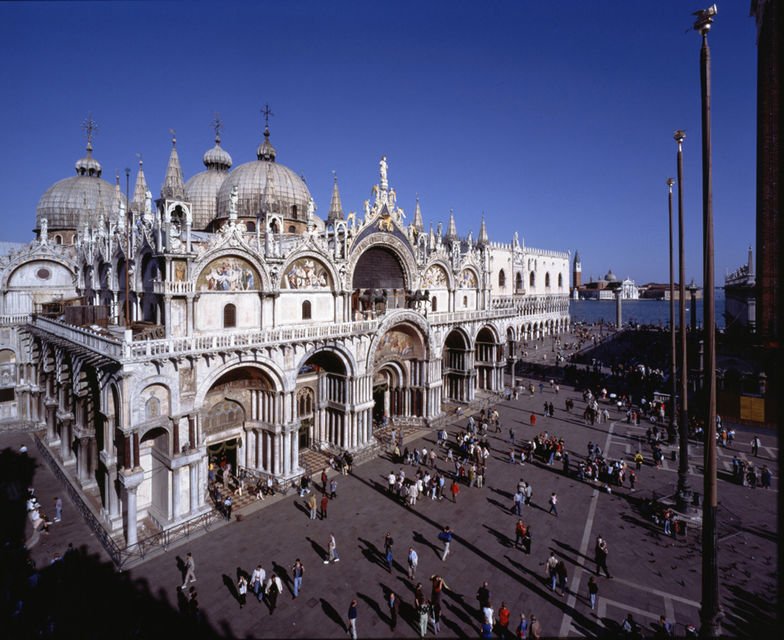St Mark’s in Venice is an Astonishing Place to Worship

APPROACHING VENICE on the excitingly speedy vaporetto (No 4.2), which has a pointed prow and leans backwards when it accelerates, so that passengers in the open air in the stern are below the water level of the kicking wake as it makes miniature rainbows in the January sunshine – approaching Venice like that, I was reminded of something by a prominent brickwork campanile.
It was too much like an industrial chimney to appeal straightforwardly, but the shape at the top resembled the beloved British telephone box, the K2, designed by Giles Gilbert Scott.
The kiosk is topped with a segmental pediment on each side, and so is the campanile.
The tower turned out to belong to the church of Santa Maria dell’Orto. This church has a whacking great Gothic interior behind a modest facade cheered by a statue of St Christopher. To him the church was dedicated, taking its popular name from a solid but winning four
teenth-century statue of the Virgin and Child once apparently left out in an orchard.
I won’t go on any more about architecture because I had in mind the interesting challenge of going to church in Venice. It’s easy to visit bucketfuls of churches, especially if one is happy, having come all this way, paying three euros to do the tourism. In that way, Santa Maria dell’Orto is ideal, a crowd-free walk from the vaporetto stop named after it – or more interestingly, from the San Marcuola stop on the Grand Canal, via the Ghetto and the Campo dei Mori with its curious old life-size figures with great stone turbans mounted on the walls of houses.
The question is where to go to Mass. St Mark’s seems to discourage the habit on Sundays. The authorities may wish to prevent sightseeing under the guise of piety. But if you turn up for the 6.45pm vigil Mass, you find the main doors closed. Entrance is by an unmarked door in the north facade, through a curtain. It’s an astonishing place to worship, but the music isn’t up to much and the congregation fills only a few rows.
For a weekday Mass, I have a soft spot for Santo Stefano, with its alarmingly leaning campanile and a Gothic interior even vaster than Santa Maria dell’Orto, freezingly, damply cold. Mass is usually at 7pm, and the handful of dear old Venetians take refuge in the warm little chapel where the Blessed Sacrament is reserved. They all know each other and enquire in a friendly way where the stranger is from, too.
“HERE YOU ARE,” said the proprietrix of the Vecio Fritolin triumphantly. Fish are slippery things to translate, and I was delighted when she produced for me, like some family Bible, a book by the late Alan Davidson, authoritatively establishing that turbot in Italian is rombo (not because it rumbles but because it is a rhombus or diamond shape).
What I protest about is the northern Italian habit of calling a croissant a brioche. When Marie Antoinette, according to unreliable Rousseau, said “Qu’ils mangent de la brioche”, she wasn’t thinking of flaky-pastry croissants but bunlike goods.
It is to Alan Davidson again that I am grateful for exploding the myth that croissants owe their identity to bakers who raised the alarm on hearing Turks attempting to tunnel under the walls of Budapest in 1686. He ran the myth to earth in the first edition of the Larousse Gastronomique. So this immemorial tradition originated only in 1938.
ENTRY TO ST MARK’S is free (compared with £22 for Westminster Abbey), but an incomparable bargain is to pay five euros to climb 40 steep steps that did my knee joints no favours, up to see the glorious bronze horses, and the most captivating view (if you like views) in Europe, not into ugly St Mark’s Square, made worse by Napoleon’s demolition of the Church of San Geminiano that used to punctuate the west wide, but down the Piazzetta, past the Doge’s Palace and between the gigantic pillars with the lion of St Mark and the crocodile of St Theodore, across the aquamarine sea to San Giorgio Maggiore. What surprised me most, though, was inside the basilica. The centre of the mosaic dome of Pentecost depicts the Holy Spirit as a dove sitting on a cushioned throne. It is most striking.
Christopher Howse is an assistant editor of The Daily Telegraph.


 Votes : 0
Votes : 0









